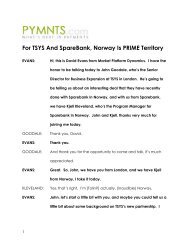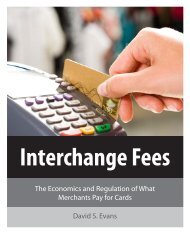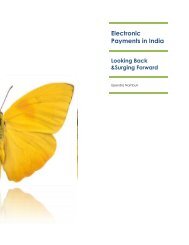Lydian Payments Journal - PYMNTS.com
Lydian Payments Journal - PYMNTS.com
Lydian Payments Journal - PYMNTS.com
Create successful ePaper yourself
Turn your PDF publications into a flip-book with our unique Google optimized e-Paper software.
Further evidence of fragmentation can be observed in a study by Ryan Bubb and Alex Kaufman. 18 The<br />
authors <strong>com</strong>pare the credit card practices of banks to credit unions and find substantial differences. As<br />
shown in Figure 6, credit unions have much more uniform pricing, while bank pricing is highly fragmented.<br />
This is not surprising since the mission of credit unions is to act in the interest of their members, who are<br />
also their borrowers while the mission of for‐profit banks is to maximize profits. Banks have an incentive to<br />
fragment prices in a way that sends powerful signals while raising prices in underweighted areas. Credit<br />
unions may not have as strong an incentive to do so because such fragmentation would in effect be<br />
deceiving their own members. 19<br />
Figure 6<br />
Source: Bubb & Kaufman, 2009. Reprinted with permission.<br />
“Shrouded” Costs (or Reductions in Benefits) are Prevalent<br />
Credit cards clearly include numerous shrouded costs. Two that have already been mentioned include<br />
penalty APRs and payment allocation mechanisms. The payment allocation policy utilized by issuers was<br />
found be a shrouded attribute of the product. Consumer understanding was extremely low. When<br />
surveyed, only 3.4% of the public got three basic questions right that were necessary for understanding<br />
18 Ryan Bubb and Alex Kaufman, “Consumer Biases and Firm Ownership,” working paper, Harvard University,<br />
September 2009, available at<br />
http://www.people.fas.harvard.edu/~ryanbubb/papers/BubbKaufman_ConsumerBiasesandFirmOwnership.pd f<br />
19 While credit unions have much less fragmented prices, this practice is not universal. Some credit unions have<br />
offered credit cards in partnership with some of the issuers with the most aggressive pricing (possibly without being<br />
aware of the full implications of their practices). Likewise, in other areas (such as overdraft fees), a number of credit<br />
unions use the same policies as the large banks.<br />
© 2009. Copying, reprinting, or distributing this article is forbidden by anyone other than the publisher or author. 35








